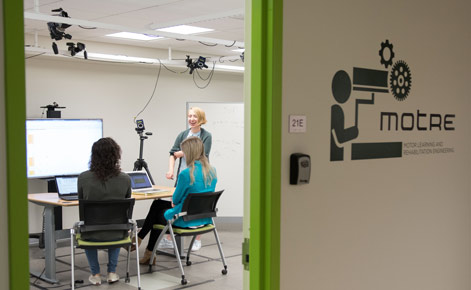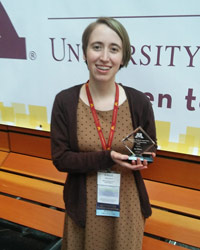 Aimee Tomlinson is known for finding, and solving, problems in an award-winning way.
Aimee Tomlinson is known for finding, and solving, problems in an award-winning way.
Tomlinson, who is studying Kinesiology at Michigan State University, was selected to join the 2018 National Science Foundation Graduate Research Fellowship Program in June. The national recognition was given to 2,000 scholars across the country; Tomlinson was one of nine at MSU.
“Finding out I received a fellowship was one of the happiest days of my life,” Tomlinson said, noting the $34,000 annual stipend and $12,000 for cost-of-education expenses provided will allow her freedom to focus on research. During the five-year fellowship, she will continue working in the Motor Learning and Rehabilitation Engineering Lab (MOTRE) with Assistant Professor Rajiv Ranganathan.
“She came to the doctoral program in Kinesiology with a nice mix of quantitative skills and being able to appreciate the challenges related specifically to human movement,” Ranganathan said.
Drive and data
She also came with ideas that would eventually result in being selected from among the more than 12,000 scholars who applied for the 2018 NSF Graduate Research Fellowship.

Tomlinson works with graduate students in the MOTRE lab in IM Circle.
Collaborating with Professor Subir Biswas in the MSU College of Engineering, Tomlinson and Ranganathan are hoping to better understand how people move after a stroke and what can be done to correct improper movements.
“I am studying how unimpaired and motor impaired individuals move their bodies when reaching,” Tomlinson said of her current research trajectory, which will be the focus of her NSF project and dissertation. It builds on research she began upon entering MSU in fall 2017, after she earned her bachelor’s in engineering at Lawrence Technological University. The same semester she started at MSU, she was presented with a Erickson Research Fellowship.
“After a stroke, patients can sometimes bend at the waist to compensate for a lack of function in an arm. I am trying to learn how people move, and then quantify information.”
The three scholars are developing a feedback device integrated with a handful of sensors that will alert the user when they are performing a “maladaptive,” or over-compensating reaching task. Strategies learned with the MOTRE lab tools will help users to correct that and to relearn how to use function in the impaired arm.
“One of the biggest things that makes Aimee successful is her ability to understand the process of research,” Ranganathan said. “Research isn’t step one, two, three. It has its ebb and flows. Students new to research can sometimes find that frustrating, but she is able to take it in stride because of her previous work and experience doing research.”
You really need drive in a research environment to be successful,” Ranganathan added. “Aimee has that drive; earning a NSF Graduate Research Fellowship is an example of that.”
A novel product
Tomlinson’s drive is perhaps best exhibited in the form of a patent-pending invention.
She was always curious and innovative, wanting to understand things better. That fit right in line with a senior thesis project while at Lawrence Technological University. She and collaborator Meagan Mazurek were tasked with finding and solving a problem in the medical field. After talking with professionals, they decided to focus on improving CPR—specifically compressions.
There was a CPR feedback device already on the market that could be placed on a patient to indicate if compressions were adequate enough. However, the feedback wasn’t intuitive, and medical providers described them as uncomfortable to compress into, so most ambulances didn’t carry them.
Tomlinson and Mazurek decided to make a better device. They created a pliable, color-coded apparatus to provide clear feedback and comfortable usage for the user.
After that, Tomlinson’s life was a bit of a whirlwind.
They created a prototype in spring 2017, meeting with firefighters for testing. In fall 2017, a graduate student at the Wayne State Patent Clinic helped write the patent application—and at the same time, she started in Michigan State University’s doctoral Kinesiology program. In April 2018, she was the only woman out of six submissions selected to present at the Design of Medical Devices Conference in Minneapolis, Minn. She presented in the Emerging Medical Innovation Valuation Competition.
To top it off, Tomlinson won first place.

Tomlinson poses with her award at the Design of Medical Devices Conference in 2017.
As a result of her winnings, in August of 2018, she was connected with the University of Minnesota and assigned a research team who would conduct market research and testing on the product.
For now, the “novel CPR feedback device,” (as close to a name for the product as Tomlinson and Mazurek have settled on) is a “hobby side project,” Tomlinson said with a laugh. Patents take roughly 18 months for the entire confirmation process; Tomlinson expects to hear results in June 2019.
The NSF Graduate Research Fellowship Program began in 1952, and is the “nation’s oldest continuous investment in the U.S. STEM workforce.” To learn more, visit the NSF website.




